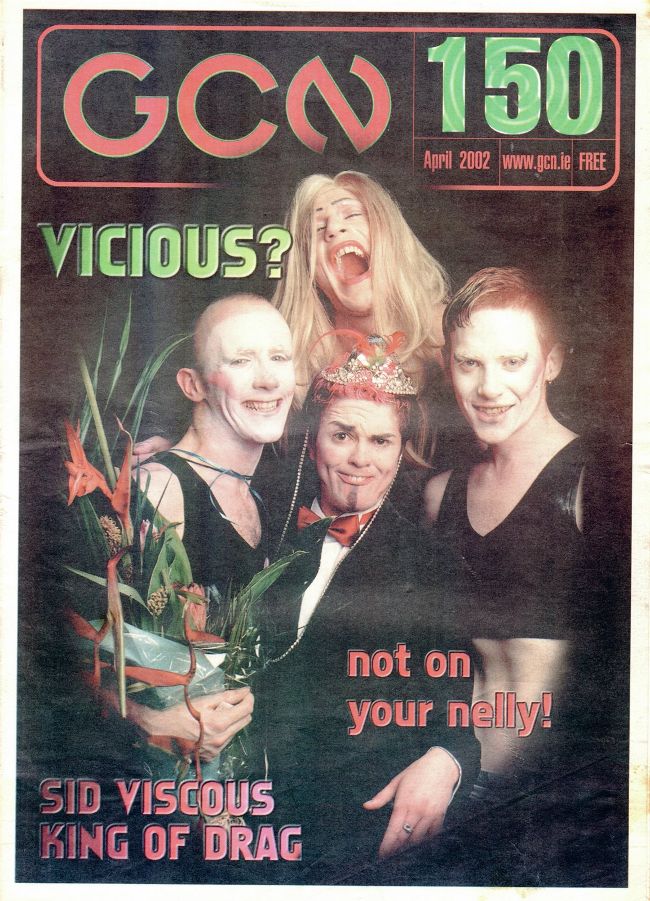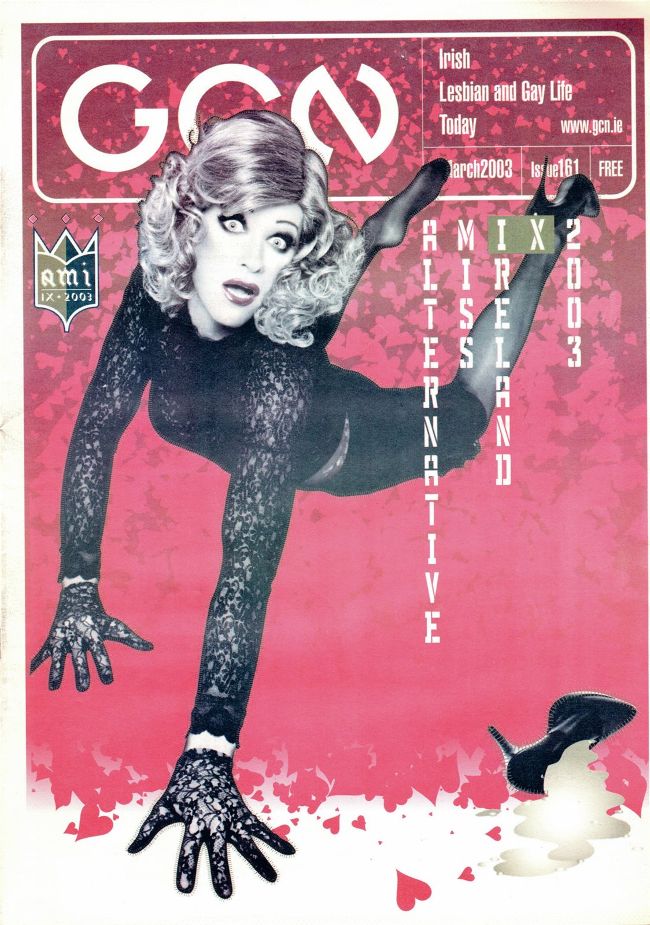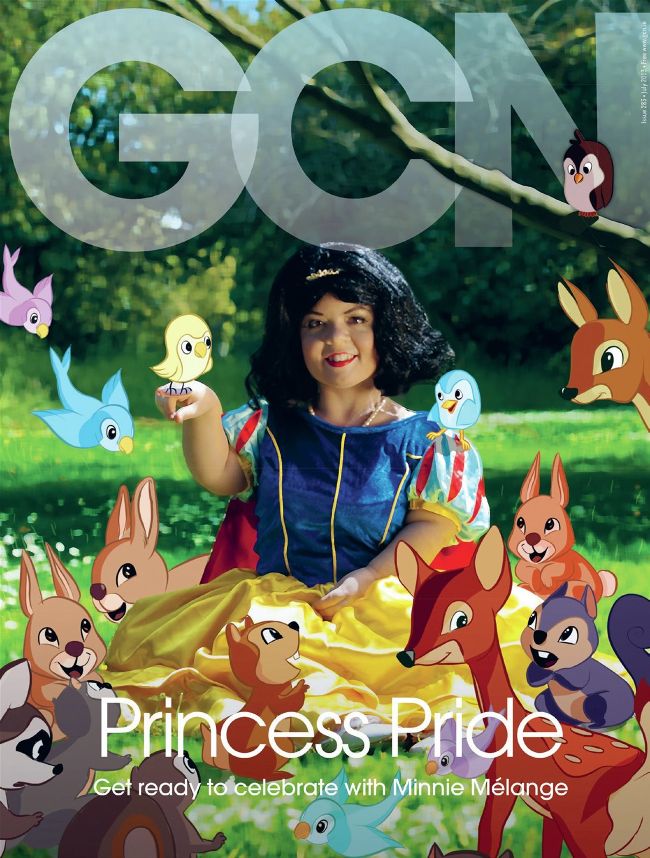AMI – Drag – Gay Christmas
Long Live the Queens
What started (and continued) as a fundraiser for the LGBTQ+ community soon rivalled Pride as the biggest Irish queer event of the year. Hannah Tiernan remembers the iconic, euphoric, Alternative Miss Ireland.
Hannah Tiernan
Before RuPaul’s Drag Race was even a bun in the oven, Ireland had its very own annual drag pageant. Each year, on the Sunday nearest St Patrick’s Day, queens, kings, discombobulated humans of all sorts and, on one occasion, even a dog, would don their gay regalia and take to the stage of Dublin’s Olympia Theatre to amuse, confuse, challenge and entertain judges and audiences alike. From its origins as a one-off fundraiser in Sides Dance Club to its run as ‘Gay Christmas’, Alternative Miss Ireland would reshape Ireland’s drag scene indelibly and go on to raise thousands for AIDS charities.
But to call Alternative Miss Ireland merely a drag pageant is an injustice. In the immortal words of Panti, it was “the annual Irish beauty pageant just beyond the finish line of culture… Grabbing the traditions of daywear, swimwear and eveningwear by the heels and dangling them over the Ha’penny Bridge until something falls out, this pageant embraces men, women and anything else that you can imagine; thrashing out on stage for the crown.” And it did just that; you never knew what to expect from year to year, let alone from act to act. It was part drag, part burlesque, part comedy, part performance art but at its heart, wholly beautiful mayhem.
On April Fools Day 1987, nine men and women crammed themselves and their costumes into a tiny make-shift dressing room beneath the stairs of Sides Dance Club on Dame Lane. As the evening’s compere, Linda Martin beckoned, contestants would make their way gingerly up the spiral staircase. A delicate manoeuvre in heels, wig and body paint but an even taller order when sporting a rather imaginative three-foot-high replica of Rathmines Town Hall on your head, or worse, three phallic-shaped missiles filled with four gallons of fluorescent paint and flour set to explode. Once above ground, they strutted their stuff down the 40-foot long catwalk as Twink, John Rocha and the other esteemed judges hovered on shaky scaffolding above to decide the worthy recipient of the coveted first place prize -a pair of tickets to New York. Needless to say, the worthy recipient was the explosive, Miss Isle.
The event was modelled on English artist, Andrew Logan’s Alternative Miss World with the added Irish flare of The Rose of Tralee meeting Housewife of the Year. The first iteration in Sides was organised by celebrity hairdresser, Ross Elliott Tallon, Sides co-owner, Frank Stanley and graphic designer, Niall Sweeney - who would go on to define the image of AMI and would remain a linchpin for the next 25 years.
It was intended to be a one-off event with a third of the proceeds going to the Dublin Rape Crisis Centre. It was this very philanthropy that would bring about its return nine years later, and ultimately set a precedent for the subsequent events.
By the end of 1995, Panti and Niall had begun to make a name for themselves with their club night GAG. The faux-fetish night catered for revellers brought together by a love of music, hedonism and all things alternative. The nights were capped off by Panti and Niall’s (aka Mr Sphincter) outrageous performances, which often involved Mr Sphincter retrieving various objects from Panti’s derriere. Madcap antics aside, Dublin AIDS Alliance, in their better wisdom, approached Niall, Panti and Trish Brennan (aka Trish Dalish) to ask if they would be interested in running another Alternative Miss Ireland as a fundraiser. When they said yes, little did they know what an enormous lipsticksmacked, wig-wearing, sequin-clad beast they had awoken.
Throughout the rest of Alternative Miss Ireland’s years, philanthropy would be at the heart of every event but more specifically, HIV and AIDS charities would form the backbone of this selfless endeavour. Over the following 17 years, AMI would go on to raise more than €300,000 in funds for HIV and AIDS charities both at home and abroad.
The worthy successor to the inaugural event took place in the newly built Temple Bar Music Centre in 1996. AMI landed with all the regalia of a carnival, so much so, that gold spray paint stained the brand new floor for years to come. This was to be a ride like nothing seen before.
The performances were another heady mix of inspired and bizarre concoctions. There was Tonie Walsh’s Miss Ravin’ Meadbh, who only became a fully-fledged raven after being loved up by a giant bull cock wearing a condom that had been hiding inside the Salmon of Knowledge. Meanwhile, Miss Fisch pulled not one but three snakes from her fanny, as Miss Interpreted drove a motorbike through the loading doors and straight into the unsuspecting audience.

But the chaos didn’t end on stage. Up in the balcony, beyond the prying eyes of the audience sat a star-studded lineup of judges. Not to blame any make-up mishaps, but the show’s start was delayed by a full hour, during which the judges proceeded to imbibe the endless complimentary champagne. Needless to say, by the end of the night, things got more than a little messy as heckles raised and profanities flew. In a fit of indignation, two of the more inebriated guests stormed off down the extremely steep and long staircase. As they clumsily negotiated their descent, one tripped and fell backwards. Thankfully, a kindly gentleman who’d been co-opted to ‘mind’ the esteemed guests managed to break her fall, and with the help of her friend, slowly craned her back into an upright position.
In true AMI style, the kindly gentleman, Tom Gleeson - who had arrived that night as a spectator - had now been inducted into the AMI family and the following year went on to become stage manager. Alternative Miss Ireland was built on the shoulders of all of its volunteers, each played their parts and gave selflessly. Whilst some came for the camaraderie, most came silently for the love and memory of the friends that they had lost to AIDS. Upon recalling taking quiet moments of reflection backstage, Tonie Walsh suggests, “it was about waving goodbye to all our beloveds, which is a huge part of what AMI was about”.
AMI’s third outing in 1997 didn’t disappoint. By then, Niall and Panti had begun running Powder Bubble, a monthly club night in the Red Box in the old Harcourt Street Railway Station. It was a cavernous space, well suited to dance clubs and gigs but not ideal for the raucous stage show that was AMI. But AMI and Powder Bubble fitted together like a well-worn glove and no venue mismatch was going to put a stop to that.
A marquee was erected in the car park to accommodate the contestants’ ever-expanding wardrobes and egos. The lack of any raised platform at which to observe proceedings meant that the judges were given prime real estate in front of the stage, leaving them in the firing line of whatever mishaps may ensue. And ensue they did, namely by way of an ice coffin which was used to transport an entombed Miss As Yet Untitled to the stage. The coffin was carried precariously through the crowd. Inevitably, the journey took longer than intended and in an attempt to avoid hypothermia, the contestant threw off the lid, sending smashed shards of ice flying onto the judges’ table. The coffin caused further chaos as it began to melt under the hot stage lights, sending the meltwater pouring straight to, you guessed it, the judges’ table again.
However, the night belonged to the winner and the judges weren’t slow about awarding it to the crowd’s preferred contestant, Miss Shirley Temple Bar. As the photographer and Queen of Ireland director, Conor Horgan recalls, ‘...at that point, the judges weren’t safe in a separate dedicated box like they were in the Olympia Theatre. We were at a table in front of the stage with the entire audience bellowing at the back of our heads “SHIRLEY, SHIRLEY, SHIRLEY!” I’d never seen a star being born like that. Like literally, I saw a star being born, we all did’.
1998 saw AMI standing proudly at the front of the maternity ward door, ready to pop out the next aspiring Queen Cailín. With a few adjustments such as stage curtains and a new and ambitious set, the Red Box remained the venue for AMI’s fourth outing. The evening saw the return of some familiar faces such as Miss As Yet Untitled (of ice coffin fame) and, the contestant that would go on to become the competition’s most frequent flyer, Miss Big Chief Random Chaos. Chaos by name and chaos by nature. His trademark mohawk and white painted face, immediately made him hard to miss. Costumes ranged from a welded iron-framed tutu to matching Friesian cow-print bikini, bodice and waistcoat, to a three-foot-long prosthetic cock. However, he really made a name for himself when he performed an on-stage endoscopy.

Among the other contestants that night were two brand new faces that would go on to become stalwarts of the Irish drag scene. One in the guise of Miss Xena Warrior Princess, really Dizzy in disguise and the other as Miss Vada Bon Rev. The Queen Cailín of the night was Miss Tampy Lilette, a Country and Western loving cowgirl with women’s problems. Her eveningwear costume spoke volumes, a crimson puffy ballgown, white tuille shawl stained red in parts, all topped off by a red stetson festooned with dangling tampons. Miss Lilette was to become AMI’s next super-starlet. Following her win, comedienne Katherine Lynch went on to host her regular Thursday night show G Spot in GUBU, the predecessor to Pantibar, later collaborating with the 2003 queen, Miss Alter Ego.
Despite her win, Miss Lilette was upstaged at the end of the night by the disgruntled runner-up, Miss Vada Bon Rev. After being awarded a flower bouquet and the secondplace trophy, The Golden Briquette. Miss Bon Rev lined up at the back of the stage alongside her fellow contestants to watch Miss Lilette be crowned. Just as Miss Lilette finished her speech, Miss Bon Rev flung her bouquet through the air directly towards the judges’ table. As Ailbhe Smyth dived to avoid the projectile, it landed inches away from hitting Louis Walsh.
AMI rang out the end of the millennium for the last time in the Red Box. Having effectively been crowned Queen of Drama, the renamed and reinvigorated Miss Veda Beaux Rêves was more determined than ever to win the Medusa Crown of Shamrocks. She saw off competition from names such as Miss Ivana Visa, Miss Liza Millenium, Miss Steak, Miss T Period and yet another guise of Dizzy’s, the aptly named, Miss Me_Tamorphosis. Evidently a glutton for punishment, judge Louis Walsh, suggested rigging the votes to make Veda come in second place again, in the hopes of inciting another riotous act. However, his fellow panellists justly awarded her the crown, and so it was that AMI’s third drag superstar was born.
The new millenium brought with it a new home as AMI took up its final residence in the iconic Olympia Theatre. The first crown bestowed in the Olympia fittingly went to Miss Siobhan Broadway. It was her eveningwear performance that sealed her the top spot, with the props truly living up to the ostentation of her surroundings. Her act began rather ordinarily as she stood on stage singing. A few minutes into her number, she disappeared behind a curtain to the back of the stage. All of a sudden, the curtain spun a full 180 degrees to reveal a replica of the stage with Miss Broadway standing front and centre. This time she was accompanied by six life-size puppets who danced in synchronicity to the movement of her cane. What better way to signal AMI’s arrival in the theatre than to recreate the theatre itself.
The Olympia also saw the arrival of two new fixtures. While The Muppet Show had Waldorf and Statler, AMI had Dizzy and Dolly. Like your favourite critical aunties, they held out a helping hand to the contestants while hiding a wooden spoon behind their back in case anyone slipped out of line. They mopped up all the thrills and spills -mainly as a result of the vodka they imbibed with Panti from the comfort of their on-stage couch propped just in front of the wings. The jibing duo flung critique and compliment, and more often than not, their antics and expressions were more entertaining than the acts themselves. In reality, the audience was seeing the painted faces of two of the show’s backbones. Stagehands of sorts in front of the curtain but behind the scenes, Dizzy was the clipboard-wielding stage manager for 11 years following Trish’s departure.

Whilst AMI had had plenty of female contestants, it had never seen a drag king until 2001 and that king went by the name of Johnny Silvino. With chiselled features and a perfectly groomed goatee, the debonair gent was a huge hit with the ladies, but alas his wiles were lost on the judges and he missed out on taking the crown home. But Johnny hailed the reign of another king and in turn the beginnings of Ireland’s first drag king troupe. The following year saw the glorious ordination of the very first Alternative ‘Mister’ Ireland as Sid Viscous took on the Medusa Crown of Shamrocks. Sid perfectly encapsulated the ‘alternative’ persona, chef by daywear, boxer by swimwear and tiara and a tuxedo-wearing gentleman by eveningwear, all capped off by a pink mohawk. Outside of AMI, Sid was The Muppets meets Sid Vicious; punk with a marshmallow inside.
Shortly after Sid’s win, organiser of @LAF’s (a Lesbian Arts Festival), Tracy Martin, received a call from a Chicago-based drag king troupe, The Windy City Blenders, wondering if Dublin had a troupe that they could twin with by way of an exchange, and so it was that the Shamcocks were born. They gathered a group of eager friends and set about discovering their masculine sides. Tracy became Gringo O’Hara, a mankini-wearing Dublin cabbie with a mouth as filthy as the abundant pubes he struggled to contain inside his spandex. He went on to become the 2004 AMI runnerup. Among others, they were joined by Stanley Knife, Slick O’ and Phil T Gorgeous. The troupe would perform regularly throughout Dublin’s gay bars, as well as hosting several drag nights in the Sugar Club on Leeson St, to raise funds for their trip to Chicago. When the troupe eventually split, members went on to form the burlesque group, Pony Club and the cabaret group, Doppelgang. Over the years, some of the kings have continued to favour the more alternative burlesque circuit, whilst Phil T Gorgeous has gone on to host The George Bar’s Win Lose or Draw with Bunny O’Hare.
As it grew from a back-alley nightclub through the redeveloping Temple Bar, to a converted train station and on to one of the city’s main theatres, AMI seemed to effortlessly reflect the growth and advances within the nation’s queer landscape, born in a time when it was illegal to be gay, and coming of age as Ireland introduced civil partnership. Never ones to miss a beat, the team driving AMI were wise to this and had decided a number of years beforehand that its 18th birthday should be its last. Societal change wasn’t the only motive for calling it a day. New treatments meant that AIDS was no longer a death sentence and there was less urgency to support the charities than there had been. At the end of the day though, 18 years is longer than a lot of marriages and the commitment and effort it took to launch each AMI was like hosting 30 weddings all at once. The brides needed handholding, the seating arrangements had to be made and the stage needed to be set to the audacious standards that the revellers had come to expect. Time had taken its toll and energy and availability were exhausted.
AMI held a mirror up to Ireland and then fractured it to get a better picture. Underpinning all of its performances was the question of what it means to be Irish and queer. Be that overtly, from its staging alongside St Patrick’s Day, its Queen Cailíns or its prizes - the Silver Shillelagh, the Golden Briquette and of course, the Medusa Crown of Shamrocks - not to mention many of its performances (when in doubt stick with the tried and tested green). Or by casting a spotlight on the hot topics of the day such as; nuns and priests blaspheming their way across the stage; (safe or not) sex scenes played out to the verge of pornographic; human AIDS ribbons and walking HIV viruses; wedding dresses screaming “let us marry”; women bleeding, the list goes on.
The words of the AMI team sum it up best, “Sometimes it seems that we made the whole thing up as we went along. Who knows, really, why we embarked on this odyssey? We were all dressed up and had nowhere to exorcise, so we made a stage of our world and then acted ourselves out upon it. And along the way we’ve been joined by all these others: Miss-Placed and Miss-Judged and Miss-Guided and Miss-Fortune. Clowns and Fools, Kings and Queens, Friends and Lovers.”